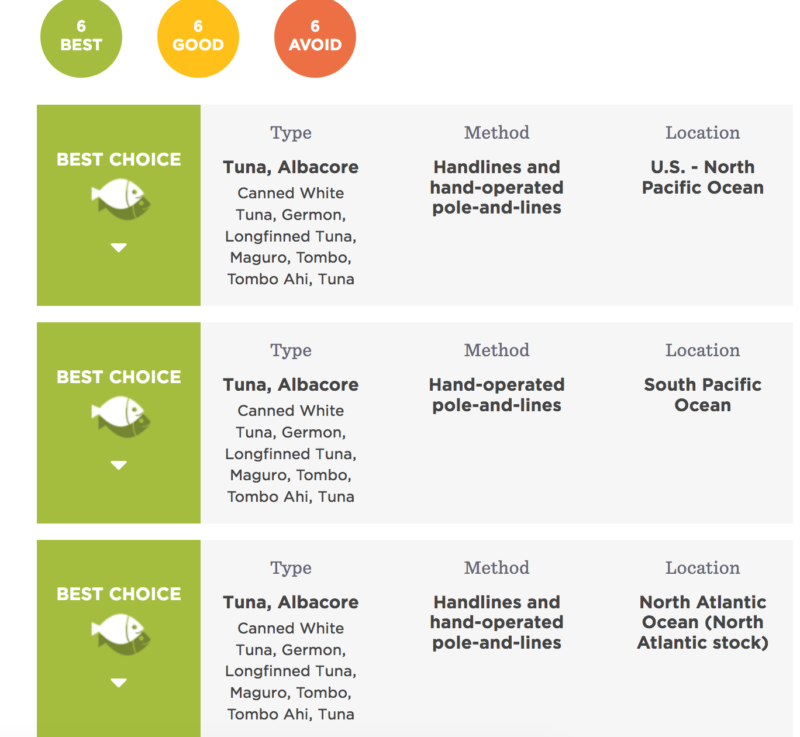The American Heart Association recommends eating fish containing Omega-3s, including albacore, at least twice a week to lower the risk of heart disease. It’s an excellent source of lean protein, vitamin A, vitamin B, selenium, niacin, and is low in sodium.
Omega-3s have been shown to:
- Reduce the risk of coronary heart disease
- Help with circulatory problems such as varicose veins
- Reduce blood triglyceride (fat) levels
- Reduce the risk of secondary and primary heart attack
- Benefit those with rheumatoid arthritis and cardiac arrhythmia
- Help in treating depression and anxiety
- Reduce the risk of stroke
Why Wild?
The fish you buy in the grocery store is either caught in the wild (in an ocean, river or freshwater lake) or raised on a fish farm.
Though farm-raised fish contain Omega-3s in levels similar to that of wild fish, they also tend to have more total fat and calories. They may also have higher levels of contaminants because of toxins present in the feed given to fish that are farm-raised.
Many of the concerns about farmed fish stem from variable environmental and health standards at farms in countries outside the U.S. As with many agricultural processes, the methods used and environment in which fish are raised affects the quality of the final product.
Monterey Bay Aquarium
The SEAFOOD WATCH program at Monterey Bay Aquarium has named Albacore Tuna a “Best Choice” for consumers who prefer to select fish and seafood that are healthy choices with little or no bycatch.

“Albacore caught by U.S. fleets in the North Pacific Ocean with handlines and hand-operated pole-and-lines is a “Best Choice.” The albacore population in the Pacific is healthy, and overfishing is a low concern. Also, there’s little to no bycatch in this fishery.”

Albacore caught in the Pacific and North Atlantic with trolling lines or handlines and hand-operated pole-and-lines is a “Best Choice.” The stocks are healthy, and these fishing methods have minimal bycatch impacts.
Mercury and Albacore
Many news stories have addressed the issues of mercury content in seafood. Though some of the articles are accurate, many tell only part of the story or are even misleading.
Independent research tests have demonstrated that the smaller, younger albacore caught by U.S. trollers based on the West Coast have lower mercury levels than the larger longline-caught albacore, along with higher levels of important Omega-3 oils.
As outlined by the EPA, mercury occurs naturally in the environment and can also be released into the air through industrial pollution. Mercury falls from the air and can accumulate in streams and oceans and is then turned into methylmercury in the water. It is this type of mercury that can be harmful to young children and unborn babies. Fish absorb the methylmercury as they feed; it builds up more in some types of fish and shellfish than in others, depending on what the fish eat.
The Western Fishboat Owners Association has an informational paper online addressing these issues in detail.
How Much Fish Is Safe to Eat?
Most people’s fish consumption doesn’t cause a health concern. In fact, nutritionists say that most people don’t get enough fish in their diets. For most people, especially those at risk of heart disease, the Omega-3 benefits of eating fish outweigh potential risks.
The American Heart Association recommends that adults eat at least two 3-ounce servings of fish, preferably those rich in Omega-3s, each week.
Selenium as a Mitigating Factor
The reason that high doses of methylmercury can cause harm in the body is that mercury interferes with the normal metabolic activities of selenium, an essential dietary nutrient.
Supplementation with additional selenium has long been known to protect the body from adverse effects of mercury exposure. This is because the additional selenium replaces selenium that has become unusable because of mercury binding. In addition, the considerable selenium content in Wild Pacific Albacore is beneficial; selenium decreases or eliminates mercury’s negative effects on the system.
